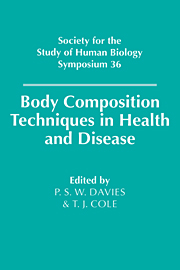Book contents
- Frontmatter
- Contents
- List of contributors
- 1 Application of dual-energy X-ray absorptiometry and related techniques to the assessment of bone and body composition
- 2 In vivo neutron activation analysis: past, present and future
- 3 Magnetic resonance imaging for the assessment of body composition
- 4 Multi-frequency impedance as a measure of body water compartments
- 5 Body composition assessed by electrical conductivity methods
- 6 Body composition in malnutrition
- 7 Influence of body composition on protein and energy requirements: some new insights
- 8 Prediction of adult body composition from infant and child measurements
- 9 Assessment of body composition in the obese
- 10 The role of body physique assessment in sports science
- 11 The assessment of the body composition of populations
- 12 Changes in approach to the measurement of body composition
- 13 Multi-compartment models for the assessment of body composition in health and disease
- 14 The future of body composition research
- Index
6 - Body composition in malnutrition
Published online by Cambridge University Press: 18 September 2009
- Frontmatter
- Contents
- List of contributors
- 1 Application of dual-energy X-ray absorptiometry and related techniques to the assessment of bone and body composition
- 2 In vivo neutron activation analysis: past, present and future
- 3 Magnetic resonance imaging for the assessment of body composition
- 4 Multi-frequency impedance as a measure of body water compartments
- 5 Body composition assessed by electrical conductivity methods
- 6 Body composition in malnutrition
- 7 Influence of body composition on protein and energy requirements: some new insights
- 8 Prediction of adult body composition from infant and child measurements
- 9 Assessment of body composition in the obese
- 10 The role of body physique assessment in sports science
- 11 The assessment of the body composition of populations
- 12 Changes in approach to the measurement of body composition
- 13 Multi-compartment models for the assessment of body composition in health and disease
- 14 The future of body composition research
- Index
Summary
Introduction
A reduction in body weight is an invariable and constant feature of inadequate food intake or any restriction of access to food both in animals and in humans. This decrease in body weight is associated with changes in the composition of the residual tissues of the body. The changes in body composition do not bear a simple relation to the changes in body weight, since other factors such as changes in hydration occur along with differential mobilisation of tissues, and these determine the nature of the body compositional changes in humans during food restriction. This chapter therefore examines the changes in body water and body fluid compartments as well as changes in body fat and the non-fat components. Differential alterations in the loss of active tissue or body cell mass as related to contributions from muscle and non-muscle tissue are examined along with changes in organ mass where data are available. This review aims to examine changes that occur in the following four conditions associated with malnutrition in humans: (1) experimental human semi-starvation, (2) malnutrition associated with disasters such as famines or wars, (3) chronic undernutrition in adults and (4) malnutrition in children.
Body composition changes during experimental semi-starvation in adults
Decrease in body weight is the most obvious manifestation of inadequate food intake in humans. However, the relationship between the degree and duration of inadequate energy intake and body weight changes is not a simple one, since important body compositional changes occur over a period of time which affect the proportion of fat stores as well as altering the level of hydration of the body.
- Type
- Chapter
- Information
- Body Composition Techniques in Health and Disease , pp. 71 - 84Publisher: Cambridge University PressPrint publication year: 1995
- 2
- Cited by



